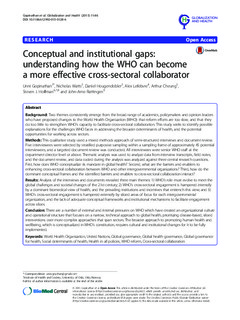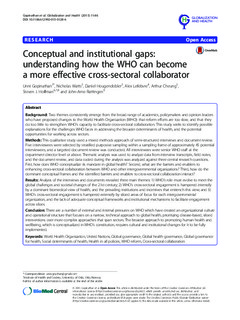| dc.description.abstract | Background:
Two themes consistently emerge from the broad range of academics, policymakers and opinion leaders
who have proposed changes to the World Health Organization (WHO): that reform efforts are too slow, and that they
do too little to strengthen WHO
’
s capacity to facilitate cross-sectoral collaboration. This study seeks to identify possible
explanations for the challenges WHO faces in addressing the broader determinants of health, and the potential
opportunities for working across sectors.
Methods:
This qualitative study used a mixed methods approach of semi-structured interviews and document review.
Five interviewees were selected by stratified purposive sampling within a sampling frame of approximately 45 potential
interviewees, and a targeted document review was conducted. All interviewees were senior WHO staff at the
department director level or above. Thematic analysis was used to analyze data from interview transcripts, field notes,
and the document review, and data coded during the analysis was analyzed against three central research questions.
First, how does WHO conceptualize its mandate in global health? Second, what are the barriers and enablers to
enhancing cross-sectoral collaboration between WHO and o
ther intergovernmental organizations? Third, how do the
dominant conceptual frames and the identified barriers and enablers to cross-sectoral collaboration interact?
Results:
Analysis of the interviews and documents revealed three main themes: 1) WHO
’
s role must evolve to meet the
global challenges and societal changes of the 21st century; 2) WHO
’
s cross-sectoral engagement is hampered
internally
by a dominant biomedical view of health, and the prevailing institutions and incentives that entrench this view; and 3)
WHO
’
s cross-sectoral engagement is hampered
externally
by siloed areas of focus for each intergovernmental
organization, and the lack of adequate conceptual framewor
ks and institutional mechanisms to facilitate engagement
across siloes.
Conclusion:
There are a number of external and internal pressures on WHO which have created an organizational culture
and operational structure that focuses on a narrow, technical a
pproachtoglobalhealth,priori
tizing disease-based, siloed
interventions over more complex approaches that span sectors. The broader approach to promoting human health and
wellbeing, which is conceptualized in WHO
’
s constitution, requires cultural and institutional changes for it to be fully
implemented. | |

